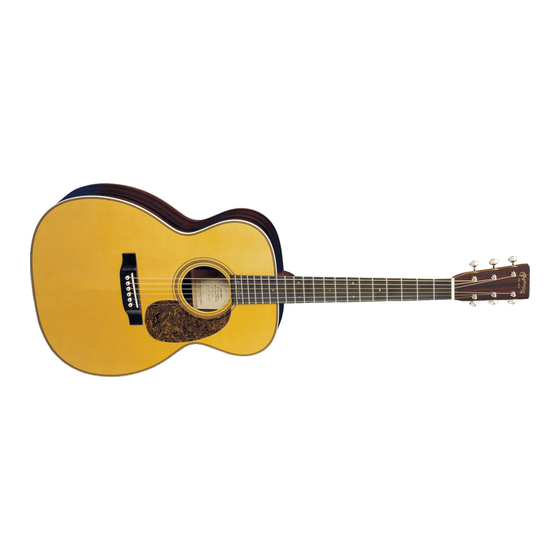Table of Contents
Advertisement
Advertisement
Table of Contents

Summary of Contents for Martin Guitar Company 0-45S Stephen Stills
- Page 2 Purchase Price Sales Slip Number This booklet will assist you in giving your Martin guitar the best of care. Its suggestions may also be a valuable aid to the owner of any guitar, but we assume no liability for damage caused by the use of this booklet in the care of instruments of other brands.
-
Page 3: Table Of Contents
Inserting Bridge Pins and Endpins ...5 Strings ...5 Adjusting the Action ...6 Necks and Tops ...7 Guitar Care While Traveling ...7 Using Guitar Straps ...9 How to String a Steel-String Guitar ...10 Solid Headstock...12 Slotted Headstock ...14 Identifying the Parts of Your Guitar...16... -
Page 4: Proper Care Of Your Guitar
When very high humidity is combined with high temperature, glue joints could possibly become weakened and may even open slightly. If your guitar is exposed to high temperature or humidity for any length of time, the glue under the bridge could weaken causing the bridge to pull off. - Page 5 Don’t set your instrument next to a source of heat or hang it on a wall where it will dry out. At all costs, avoid hanging your guitar on an outside wall during winter months. The wall will be cooler than the inside air.
-
Page 6: Cleaning The Finish
Cleaning the Finish The best way to clean your guitar is with a warm, damp cloth. This will remove harmful chemicals. Your guitar is coated in the highest grade finish available and is sensitive. Any type of solvent, especially those found in plastic, vinyl... -
Page 7: Inserting Bridge Pins And Endpins
You may want to make your guitar easier to play and use one of our lighter string sets, but your bridge saddle and neck may have to be adjusted to prevent fret buzz. -
Page 8: Adjusting The Action
12-string guitars should have lighter gauge. Adjusting the Action Often as a guitar ages, it seems to get harder to play. This is because the height of the strings above the fingerboard has increased slightly. This height, usually called “action,” is very important to the playability of the instrument. -
Page 9: Necks And Tops
Necks and Tops Neck bow itself is often misunderstood and talked about as if it is the worst thing that can happen to a guitar. For some playing styles, a slight forward bow can prevent buzzes. With the adjustable neck rod, the neck can be adjusted for relative straightness. - Page 10 Freezing or overheating your guitar is an invitation for a crack or warp to occur. Your guitar is assembled with glues that can be affected by heat causing breakdown and loosening of glue adhesion.
-
Page 11: Using Guitar Straps
Martin’s hard case will help, but a good case is not a cure-all for careless handling or accidents. Using Guitar Straps Your C. -
Page 12: How To String A Steel-String Guitar
How to String a Steel-String Guitar STEP Insert each string in its proper hole in the bridge. Keep the heaviest portion of the double winding facing away from the soundhole. STEP The string should be positioned with the bridge pin notch facing the string. - Page 13 You might occasionally encounter an older guitar with a thin bridge or a string with a longer double winding adjacent to the ball end.
-
Page 14: Solid Headstock
STEP SOLID HEADSTOCK If you have a slotted headstock, please skip to page 12. The string is passed through the string hole near the top of the tuning machine post. STEP After coming through the string hole, the string is wound one-half way around the tuning machine post. - Page 15 STEP After passing under the longer part of the string, the short portion is bent back over it. This will prevent string slippage. STEP After the string is brought up to pitch (standard tuning), it may be clipped flush with the top of the tuning machine post.
-
Page 16: Slotted Headstock
STEP SLOTTED HEADSTOCK Instructions for solid headstock instruments begin on page 10. The string is passed through the tuning machine slot from front to rear. STEP The string is brought around the under side and back to the front. Be careful not to drag the string across the surface of the headplate;... - Page 17 STEP The end is brought around the string and pulled back toward the end of the headstock. This establishes a lock which will prevent slip- page. Note that when the string is tightened, the “lock” will hold in place. STEP When brought up to standard pitch, there should be at least two full windings on the...
-
Page 18: Identifying The Parts Of Your Guitar
Identifying the Parts of Your Guitar BODY Front or Neck Block Rim Assembly Rosette Pickguard Bridge Bridge Saddle Bridge Pin Back Centerstrip Back Brace Ribbon Lining Rear Block... - Page 19 Headstock (Solid) Tuning Machines Neck (Barrel) Heel Dovetail Adjustable Truss Rod Headplate Fingerboard Fingerboard Position Dots Headstock (Slotted) Tuning Machines Non-Adjustable Truss Rod Side Dots NECK Headplate Frets...
- Page 20 C. F. Martin & Co., Inc. 510 Sycamore Street P.O. Box 329 Nazareth, PA 18064 USA (610) 759-2837 • martinguitar.com © 2005 C. F. Martin & Co., Inc. All rights reserved. Martin takes pride in its product innovations and protects many of them with U.S.


Need help?
Do you have a question about the 0-45S Stephen Stills and is the answer not in the manual?
Questions and answers